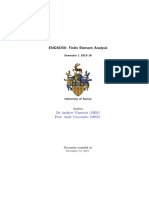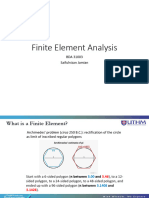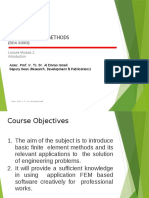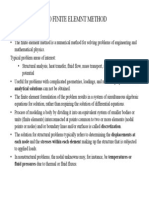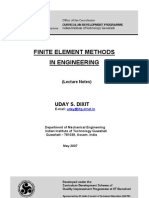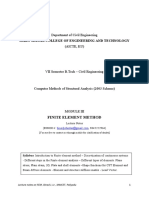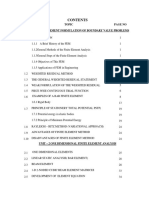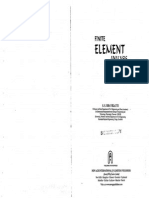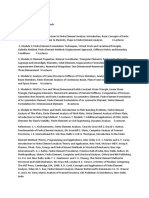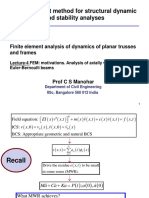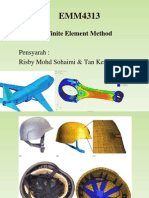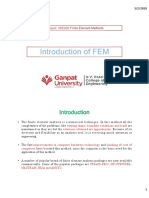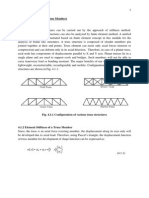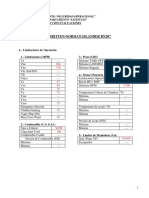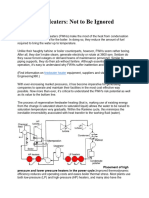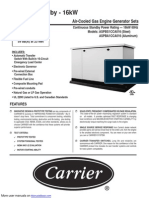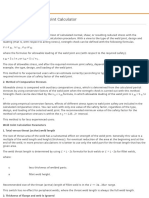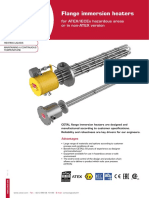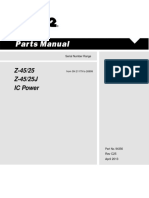Content
Module 1: Introduction to Finite Element Analysis (04)
Lecture 1: Introduction (Page: 1-6)
1.1.2 Background of Finite Element Analysis
1.1.3 Numerical Methods
1.1.4 Concepts of Elements and Nodes
1.1.5 Degrees of Freedom
�
Content
Module 1: Introduction to Finite Element Analysis (04)
Lecture 2: Basic Concepts of Finite Element Analysis (Page: 7-12)
1.2.2 Discretization of Technique Basic
1.2.3 Concepts of Finite Element Analysis
1.2.4 Advantages of FEA
1.2.5 Disadvantages of FEA
1.2.6 Limitations of the FEM
1.2.7 Errors and Accuracy in FEA
�
Content
Module 1: Introduction to Finite Element Analysis (04)
Lecture 3: Introduction to Elasticity (Page: 13-23)
1.3.2 Strain-Displacement Relations
1.3.3 Linear Constitutive Relations
1.3.4 Two-Dimensional Stress Distribution
1.3.4.1 Plane Stress Problem
1.3.4.2 Plane Strain Problem
1.3.4.3 Axisymmetric Problem
�
Content
Module 1: Introduction to Finite Element Analysis (04)
Lecture 4: Steps in Finite Element Analysis (Page: 24-29)
1.4.1 Loading Conditions
1.4.2 Support Conditions
1.4.3 Type of Engineering Analysis
1.4.4 Basic Steps in Finite Element Analysis
1.4.5 Element Library in FEA Software
�
Content
Module: 2 Finite Element Formulation Techniques (04)
Lecture 1: Virtual Work and Variational Principle (Page: 1-4)
2.1.1 Introduction
2.1.2 Principle of Virtual Work
2.1.3 Variational Principle
2.1.4 Weighted Residual Method
�
Content
Module: 2 Finite Element Formulation Techniques (04)
Lecture 2: Galerkin Method (Page: 5-10)
2.2.1 Introduction
2.2.2 Galerkin Method for 2D Elasticity Problem
2.2.3 Galerkin Method for 2D Fluid Flow Problem
�
Content
Module: 2 Finite Element Formulation Techniques (04)
Lecture 3: Finite Element Method: Displacement Approach (Page:11-16)
2.3.1 Choice of Displacement Function
2.3.1.1 Convergence criteria
2.3.1.2 Compatibility
2.3.1.3 Geometric invariance
2.3.2 Shape Function
2.3.3 Degree of Continuity
2.3.4 Isoparametric Elements
2.3.5 Various Elements
�
Content
Module: 2 Finite Element Formulation Techniques (04)
Lecture 4: Stiffness Matrix and Boundary Conditions(Page:17-21)
2.4.1 Element Stiffness Matrix
2.4.2 Global Stiffness Matrix
2.4.3 Boundary Conditions
�Content
Module:3
Element Properties (09)
Lecture 1: Natural Coordinates (Page:1-8)
3.1.2 Two Dimensional Triangular Elements
3.1.3 Shape Function using Area Coordinates
Lecture 2: Triangular Elements (Page:9-17)
3.2.1 Shape function using Cartesian coordinates
3.2.2 Higher Order Triangular Elements
3.2.2.1 Shape function for six node element
3.2.3 Construction of Shape Function by Degrading Technique
3.2.3.1 Five node triangular element
Lecture 3: Rectangular Elements (Page:18-24)
3.3.1 Shape Function for Four Node Element
3.3.1.1 Shape function using Cartesian coordinates
3.3.1.2 Shape Function using natural coordinates
3.3.2 Shape Function for Eight Node Element
Lecture 4: Lagrange and Serendipity Elements (Page:25-33)
3.4.1 Lagrange Interpolation Function
3.4.1.1 Shape function for two node bar element
3.4.1.2 Shape function for three node bar element
3.4.1.3 Shape function for two dimensional elements
3.4.2 Serendipity Elements
�Lecture 5: Solid Elements (Page:34-39)
3.5.1 Tetrahedral Elements
3.5.2 Brick Elements
Lecture 6: Isoparametric Formulation (Page:40-47)
3.6.1 Necessity of Isoparametric Formulation
3.6.2 Coordinate Transformation
3.6.3 Concept of Jacobian Matrix
Lecture 7: Stiffness Matrix of Isoparametric Elements(Page:48-55)
3.7.1 Evaluation of Stiffness Matrix of 2-D Isoparametric Elements
3.7.2 Evaluation of Stiffness Matrix of 3-D Isoparametric Elements
Lecture 8: Numerical Integration: One Dimensional(Page:56-60)
3.8.1 Gauss Quadrature for One-Dimensional Integrals
3.8.2 One- Point Formula
3.8.3 Two-Point Formula
Lecture 9: Numerical Integration: Two and Three
Dimensional(Page:61-67)
3.9.1 Gauss Quadrature for Two-Dimensional Integrals
3.9.2 Gauss Quadrature for Three-Dimensional Integrals
3.9.3 Numerical Integration of Element Stiffness Matrix
3.9.4 Gauss Quadrature for Triangular Elements
3.9.5 Gauss Quadrature for Tetrahedron
Worked out Examples (Page:68-74)
Example 3.1 Calculation of displacement using area coordinates
Example 3.2 Derivation of shape function of four node triangular element
Example 3.3 Numerical integration for three dimensional problems
�Content
Module 4: Analysis of Frame Structures (06)
Lecture 1: Stiffness of Truss Members(Page: 1-6)
4.1.1 Introduction
4.1.2 Element Stiffness of a Truss Member
4.1.3 Member Stiffness with Varying Cross Section
4.1.4 Generalized Stiffness Matrix of a Plane Truss Member
Lecture 2: Analysis of Truss(Page: 7-14)
4.2.1 Element Stiffness of a 3 Node Truss Member
4.2.2 Worked Out Example
Lecture 3: Stiffness of Beam Members(Page: 15-21)
4.3.1 Introduction
4.3.2 Derivation of Shape Function
4.3.3 Derivation of Element Stiffness Matrix
4.3.4 Generalized Stiffness Matrix of a Beam Member
Lecture 4: Finite Element Analysis of Continuous Beam(Page: 22-30)
4.4.1 Equivalent Loading on Beam Member
4.4.1.1 Varying Load
4.4.1.2 Concentrated Load
4.4.2 Worked Out Example
Lecture 5: Plane Frame Analysis(Page: 31-38)
4.5.1 Introduction
4.5.2 Member Stiffness Matrix
4.5.3 Generalized Stiffness Matrix
4.5.4 Worked Out Example
�Lecture 6 Analysis of Grid and Space Frame(Page: 38-48)
4.6.1 Introduction
4.6.2 Member Stiffness Matrix
4.6.3 Generalized Stiffness Matrix
4.6.4 Worked Out Example
4.6.5 Analysis of Space Frame
�Content
Module 5: FEM for Two and Three Dimensional Solids (08)
Lecture 1: Constant Strain Triangle(Page:1-6)
5.1.1 Element Stiffness Matrix for CST
5.1.2 Nodal Load Vector for CST
Lecture 2: Linear Strain Triangle(Page:7-12)
5.2.1 Element Stiffness Matrix for LST
5.2.2 Nodal Load Vector for LST
5.2.3 Numerical Example using CST
Lecture 3: Rectangular Elements(Page:13-19)
5.3.1 Computation of Element Stiffness
5.3.2 Computation of Nodal Loads
Lecture 4: Numerical Evaluation of Element Stiffness(Page:20-30)
5.4.1 Numerical Example
5.4.2 Evaluation of Stiffness using One Point Gauss Quadrature
5.4.3 Evaluation of Stiffness using Two Point Gauss Quadrature
Lecture 5: Computation of Stresses, Geometric Nonlinearity and Static
Condensation(Page:31-38)
5.5.1 Computation of Stresses
5.5.2 Geometric Nonlinearity
5.5.2.1 Steps to include effect of geometrical nonlinearity
5.5.3 Static Condensation
�Lecture 6: Axisymmetric Element(Page:39-45)
5.6.1 Introduction
5.6.2 Relation between Strain and Displacement
5.6.3 Relation between Stress and Strain
5.6.4 Axisymmetric Shell Element
Lecture 7: Finite Element Formulation of Axisymmetric
Element(Page:45-52)
5.7.1 Stiffness Matrix of a Triangular Element
5.7.2 Stiffness Matrix of a Quadrilateral Element
Lecture 8: Finite Element Formulation for 3 Dimensional
Elements(Page:53-59)
5.8.1 Introduction
5.8.2 Strain Displacement Relation 5.8.3 Element Stiffness Matrix
5.8.4 Element Load Vector
5.8.4.1 Gravity load
5.8.4.2 Surface pressure
5.8.5 Stress Computation
Worked out Examples(Page:60-61)
Example 5.1 Calculation of nodal loads on a triangular element
�Content
Module 6 FEM for Plates and Shells (06)
Lecture 1: Introduction to Plate Bending Problems(Page: 1-10)
6.1.1 Introduction
6.1.2 Notations and Sign Conventions
6.1.3 Thin Plate Theory
6.1.3.1 Basic relationships
6.1.3.2 Constitutive equations
6.1.3.3 Calculation of moments and shear forces
6.1.4 Thick Plate Theory
6.1.5 Boundary Conditions
Lecture 2: Finite Element Analysis of Thin Plate(Page: 11-17)
6.2.1 Triangular Plate Bending Element
6.2.2 Rectangular Plate Bending Element
Lecture 3: Finite Element Analysis of Thick Plate (Page: 18-24)
6.3.1 Introduction
6.3.2 Strain Displacement Relation
6.3.3 Element Stiffness Matrix
6.3.4 Nodal Load Vector
Lecture 4: Finite Element Analysis of Skew Plate (Page: 25-31)
6.4.1 Introduction
6.4.2 Finite Element Analysis of Skew Plate Element
Lecture 5: Introduction to Finite Strip Method(Page: 32-37)
6.5.1 Introduction
6.5.2 Finite Strip Method
6.5.2.1 Boundary conditions
6.5.3 Finite Element Formulation
�Lecture 6: Finite Element Analysis of Shell(Page: 38-45)
6.6.1 Introduction
6.6.2 Classification of Shells
6.6.3 Assumptions for Thin Shell Theory
6.6.4 Overview of Shell Finite Elements
6.6.5 Finite Element Formulation of a Degenerated Shell
6.6.5.1 Jacobian matrix
6.6.5.2 Strain displacement matrix
6.6.5.3 Stress strain relation
6.6.5.4 Element stiffness matrix
�Content
Module 7: Additional Applications of FEM (03)
Lecture 1: Finite Elements for Elastic Stability(Page: 1-8)
7.1.1 Introduction
7.1.2 Buckling of Truss Members
7.1.3 Buckling of Beam-Column Members
7.1.4 Buckling of Plate Bending Elements
Lecture 2: Finite Elements in Fluid Mechanics(Page: 9-15)
7.2.1 Governing Fluid Equations
7.2.2 Finite Element Formulation
7.2.2.1 Displacement based finite element formulation
7.2.2.2 Pressure based finite element formulation
7.2.3 Finite Element Formulation of Infinite Reservoir
Lecture 3: Dynamic Analysis(Page: 16-23)
7.3.1 Hamiltons Principle
7.3.2 Finite Element Form in MDOF System
7.3.3 Solid Body with Distributed Mass
7.3.3.1 Mass matrix for truss element
7.3.3.2 Mass matrix for beam element
7.3.3.3 Mass matrix for plane frame element
7.3.3.4 Mass matrix for space frame element
7.3.4 Time History Analysis

